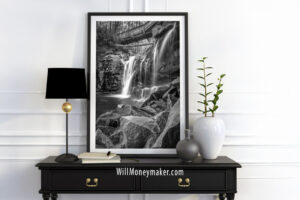What does originality really mean? As photographers, we spend a lot of time looking at the work of others for inspiration, and we also copy techniques so that we can learn them and make them our own. So where do you draw the line between “inspired by” and “copy of”? This is a particularly difficult distinction to make nowadays because we live in an age where all the “easy” photographs have already been taken. You can’t simply visit Mount Rushmore to create fine art photographs of the sculptures there; a thousand other photographers before you have already done this with that same thought in mind. You can’t visit the most famous national parks and take photographs inspired by Ansel Adams because, well, Ansel Adams already did that!
So, what does it mean to be original? It is, I think, a surprisingly difficult concept to navigate. Let’s explore a few thoughts concerning this concept of originality, and — who knows — by the end, we may be better equipped to create something truly unique!
Inspired By Versus Copy Of
In the beginning, when we get our very first camera, we spend a lot of time simply copying. We’re working out of textbooks or at the behest of our instructors. It’s an unavoidable thing. If you’re taking a class, for instance, your instructor may ask the entire class to photograph the same thing so that he or she can grade the images and point out what you may be doing wrong. In photography books, you’ll see suggestions for taking photos of common objects to learn about lighting, composition, settings and all the rest. In your own wanderings, you may seek to take photos similar to those famous photographers have created just to see if you can replicate and learn the techniques they used.
Technique is the operative word here. In this beginner phase, it’s not that you don’t have creative thoughts of your own. You may have dozens of them. Only you don’t yet have the knowledge to reproduce what you see in your mind. Instead, you find yourself doing a fair bit of emulation because you are still learning the mechanics of the art. As you go through this process, you’ll naturally create many throwaway or experimental images just because you are learning the technique. It’s a lot like that old stereotype of the art class, the one in which everyone is gathered around the same model or the same still life, all of them drawing or painting this subject, each essentially making the same piece of art. They’re not doing it for the sake of originality but for the sake of learning technique.
Later on, as you start to gain knowledge about various techniques and as your own photographic style begins to develop, you’ll find yourself taking photographs inspired by something or someone. Or, even several somethings or someones, since very few of us have only one muse. The difference with this type of creation is that, hopefully, you are putting a lot of thought into your images to create your own unique piece of artwork. You may admire and emulate the high contrast that is so prominent in Ansel Adams’ imagery, for instance, but perhaps you are applying that to an entirely different subject, or perhaps you’ve done something else to make that technique your own. The styles and techniques may be similar, but the art itself is something you’ve thought deeply about, and the meaning comes from your mind.
The World’s Top 50 Best Photo Destinations
If you’ve been online scouting potential photography locations, then you’ve doubtless seen the above headline or some variation of it dozens of times. After a quick Google search, I found Forbes, Pop Photo, F Stoppers, Picture Correct, and even National Geographic, which all produce similar articles. There were, in fact, hundreds of articles about the world’s top photo destinations, all telling you where to go, where to stand when you get there, and what to shoot if you want to create photographs that are just like those that some famous photographers took.
It’s so easy, isn’t it? It’s all laid out for you, just a Google search away. Or, perhaps that’s the problem with the digital age. Instant gratification has taken the place of careful consideration. If you’re using travel guides like this to take you on a photographic journey, are you really creating something original? If you are standing at the Grand Canyon, standing upon the same overlook that thousands of people before you stood upon to take the same photograph that you are taking, are you making art? Or are you unwittingly making a copy?
Here again, your destination, the subject material you choose, your techniques, style, and composition all require thought. Originality requires exploration of the world around you and of your own interactions with it. Don’t tread the same roads as thousands of photographers before you when you can, with careful consideration, forge your own path. Find your own destinations, subjects, and perspectives to find your own meaning.
What Separates You from Everyone Else
All of the above discussion leads me to one final conclusion. What is it that separates you from everyone else? It can only be one thing: thought. It’s not the fact that you have the best sources of inspiration, knowledge of a broad variety of techniques, or access to the world’s finest destinations. We can all achieve these things if we want them. What we can’t all do is think alike. And art, at the end of the day, is a thinking game. It demands long hours of careful consideration and self-examination. That is the only thing that can differentiate your work from the work of thousands of others.
Here are five excellent books that explore the themes of originality and creativity in photography. Each provides unique insights and practical advice on harnessing creativity and originality in photography, making them a valuable addition to any photographer's library.
The Essence of Photography, 2nd Edition: Seeing and Creativity by Bruce Barnbaum
This book delves into the deeper aspects of photographic seeing and creativity, offering insights from a seasoned photographer's 50 years of experience.
50 Paths to Creative Photography
This book covers various approaches and techniques to enhance creativity in photography, helping photographers explore new paths in their artistic expression.
Create: Overcoming Fear to Unleash Your Creativity by Marc Silber
This book focuses on overcoming creative barriers. It encourages photographers to push beyond their fears and embrace a freer, more original approach to their art.
Learning to See Creatively: Design, Color & Composition in Photography
This revised and expanded guide teaches photographers to develop a more creative photographic vision through design, color, and composition.
More Than a Rock, 2nd Edition: Essays on Art, Creativity, Photography, and Nature by Guy Tal
This book, composed of passionate essays, explores the philosophical and creative aspects of landscape photography, aiming to inspire deeper artistic expression.




